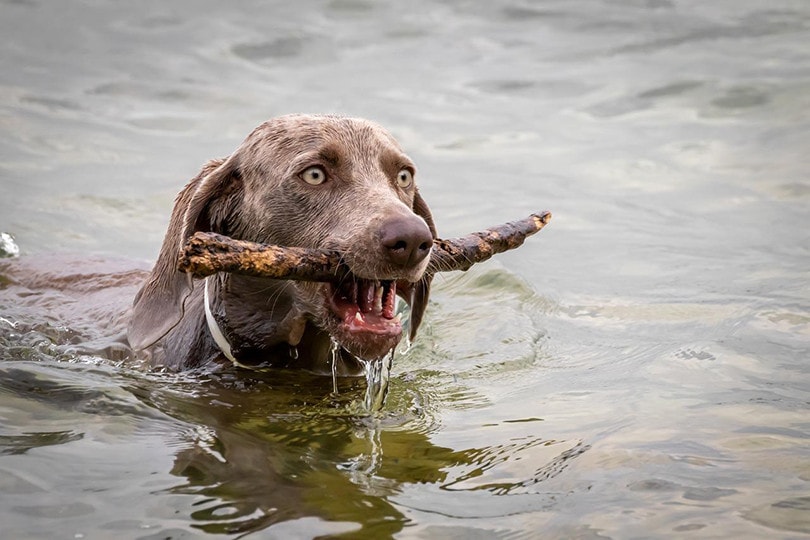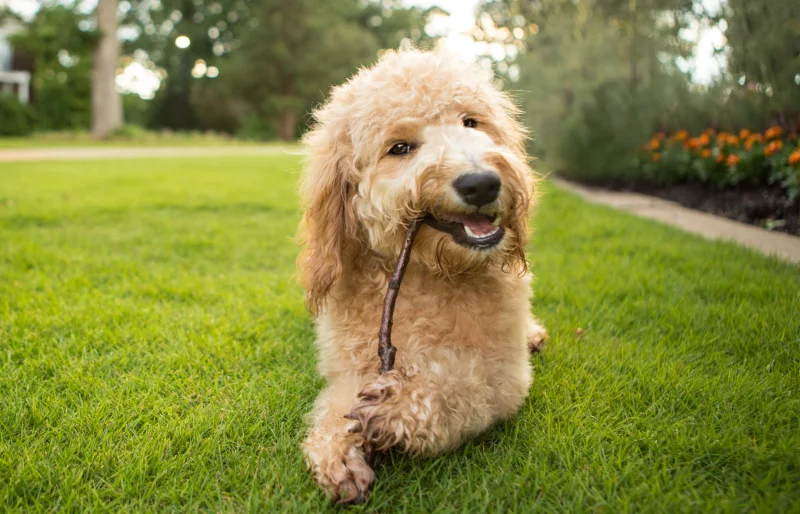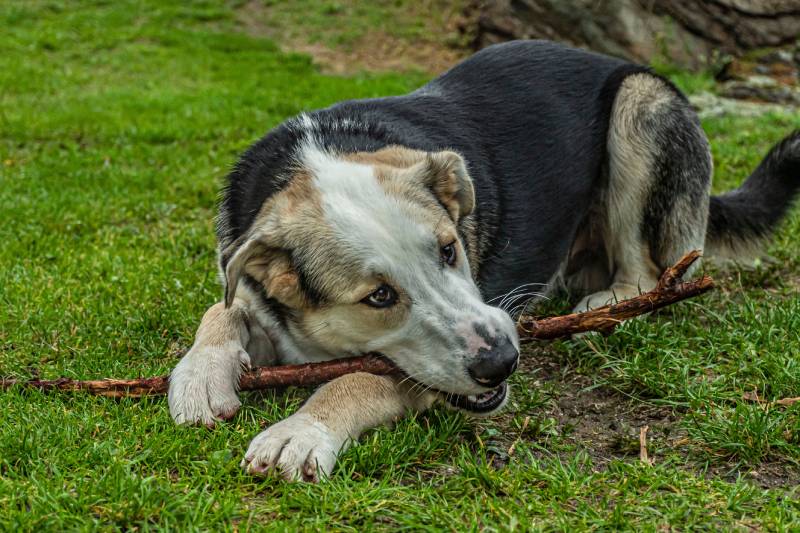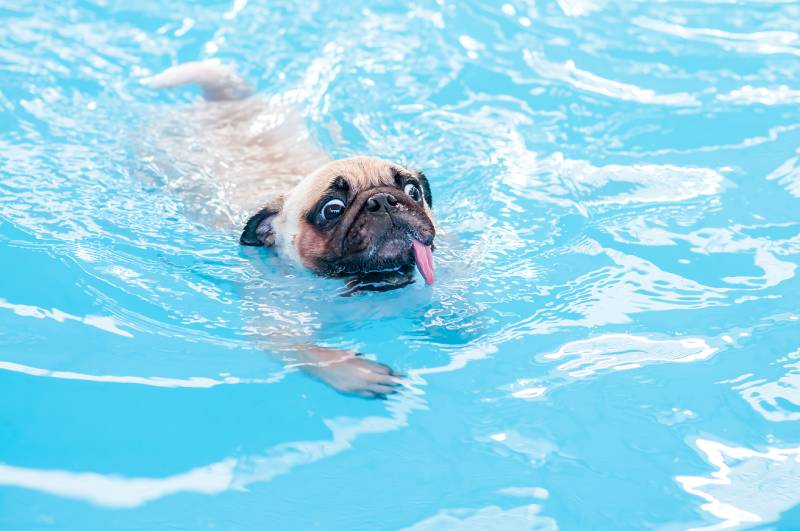Why Do Dogs Like Sticks? Risks & Safer Alternatives
Updated on

Click to Skip Ahead
Dogs like sticks because they are natural outlets for chewing and chasing, which dogs are instinctually wired for. Many dogs particularly like sticks after their humans use them to play with them. Dogs often associate sticks with playtime.
Sticks also have a rather appealing texture for dogs. They like the hard yet breakable texture, which typically encourages more chewing.
Some dogs particularly like sticks, and it may not be odd to see them carrying home sticks on their walks. However, others may not have the same enjoyment of sticks.
Risks Associated with Dogs Playing with Sticks
While sticks are typically considered harmless, there are some risks to letting your dog play with them. The primary concern is splinters. While these can be minor, very large splinters can get stuck in your dog’s lips, gum, and tongue. A dog’s mouth is a hotbed for bacterial growth, so these splinter injuries can quickly become infected. They can also become painful, especially if they are larger. Sometimes, they will come out on their own, and your dog may not even act like anything is wrong. Other times, you may need to visit the vet.
Of course, this issue is usually minor and can often be cleared up with a quick trip to your vet in most cases. However, infections always carry the risk of becoming more serious.

Splinters can also travel down your dog’s digestive tract, causing more serious issues. Again, small splinters usually aren’t troublesome. However, larger splinters can tear the intestinal walls, causing severe side effects. Surgery is often necessary to remove the splinters, especially if they get stuck in the intestines or cause impaction.
You can mitigate these risks by supervising your dog and removing the stick once it starts splintering. If the stick starts crumbling, it’s time to remove it and let your dog find another.
Of course, larger dogs that can break sticks easily are more prone to these issues. They’re much more likely to end up with a splintered stick and all of the issues that go with that.
Symptoms to Look for
There are several signs to look out for after your dog plays with sticks. Often, the signs associated with splinters inside your dog’s mouth and throat are similar, no matter where exactly the splinter is.
For one, dogs may drool excessively if they have a splinter in their throat or mouth. If possible, this is a sign for you to examine their mouth for any obvious splinters. Of course, always be safe while doing this, as dogs in pain are much more likely to bite.
Dogs may also have difficulty swallowing or eating. This can happen whether a dog has a splinter in their mouth or throat. They may refuse to eat or drink, or they may simply not eat as much as usual.
Intestinal splinters often cause vomiting and diarrhea. The body may try to expel these splinters through these means. If accompanied by blood, vomiting, and diarrhea can indicate a very serious problem.
Any changes in behavior can also be troublesome. Increased aggression or reluctance to play may all indicate that your dog is in pain, even if they aren’t showing any other signs of illness. If a dog feels a splinter in its mouth or throat, it may paw at its mouth in an attempt to remove it. Sometimes, this can be successful. However, it usually isn’t. Be very cautious if you notice your dog pawing at their mouth or rubbing their head on things.
Bleeding and swelling are always signs of an underlying problem. In this case, it may be because a rather large splinter has jammed itself into your dog’s mouth or throat. As you might guess, swelling in your dog’s airway can be very problematic.
You should also look for lethargy, which is simply when your dog isn’t as active or alert as they usually are. Often, this is a sign of a range of illnesses, including just about anything that can be caused by stick splinters.

Safer Alternatives
Some dog owners may decide that letting their dog play with sticks just isn’t worth it. You can train your dog not to play with sticks, though they’ll still need supervision wherever sticks are lying around. You may also consider offering safer alternatives and encouraging your dog to play with them.
For dogs that like to chew on sticks, consider offering tough chew toys for them to play with. Choose a toy that is suitable for your dog’s size and chewing strength. Smaller dogs probably don’t need a toy that is super durable, but you may have to invest quite a bit of money to purchase a chew toy that will stand up to a Mastiff. Still, the added cost is worth it, as it’s often these dogs that are most at risk of splintering a stick.
Regularly inspect any chew toys your dog has. While chew toys are often safer than sticks, they are not 100% safe. Whenever they start breaking apart, it’s time to replace them.
For dogs that use sticks for fetch, consider purchasing a few longer toys that you can throw. Frisbees are a popular option that is much safer than sticks, usually. (Some larger dogs may tear through a plastic Frisbee, which can be dangerous.) You can also invest in balls. There are many that are designed explicitly for tough chewers.

Dog Breeds That Love Sticks
Some dog breeds are more prone to playing with sticks than others, just due to their instincts and personality. For instance, retrieving breeds, including the Labrador Retriever and Poodles, often love to play fetch. These breeds will likely use sticks to play fetch, and they may benefit from having extra throwing toys lying around.
Terriers often love to play with just about anything. They’ll happily play fetch with a stick, but they may also just chew on them. Terriers are often small, so they can’t do much to break a larger stick. However, they may still benefit from a collection of smaller toys of all sorts, especially since they tend to be incredibly playful.
Of course, there is a lot of individual variety between dogs. Some terriers or retrievers may not even like sticks, while some hounds may be obsessed with them.
Therefore, it isn’t necessarily unusual for dogs outside of these breeds to like sticks, and it isn’t odd for dogs within these breeds to not like them.
Conclusion
Dogs play with sticks simply because they’re fun to play with. They’re a versatile toy, allowing dogs to chew and play fetch. Many dogs play with them because they learn from a person. However, there are also a lot of variances. Some dogs may adore sticks, while others may never touch them. Both are completely normal.
Sticks are usually safe for dogs to play with. However, they can cause serious injuries if they splinter. These splinters can get stuck in your dog’s mouth, throat, or digestive tract, causing all sorts of different problems.
Therefore, you may want to provide your dog with a safer alternative, such as a chew toy. This switch may be especially important for bigger dogs, which have the jaw strength to splinter sticks with ease.
Featured Image Credit: birg, Pixabay













